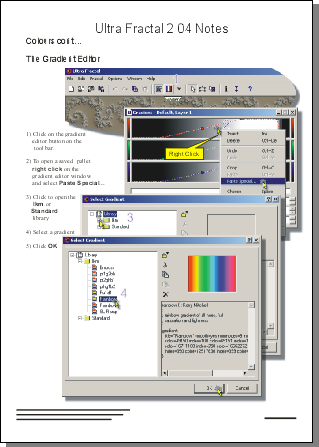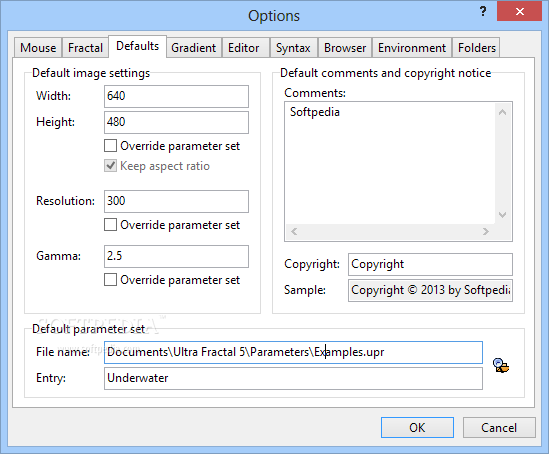

It also uses the Julia form of the **Gopalsamy Switch** fractal. The second example is called** Carvings**, and the upr is on the forum website. Note that the gradient used for lighting is not a standard lighting gradient. The user might want to try changing the tiling options and the color merge options to see the effects on the image. With the selection of a **Colors** plugin a new parameter called ' _Tiling method_' is available. The user should examine the setting in detail, as there is an additional plugin that is used called **DefaultColorMergeModes**. The user can see the areas of transparency by clicking off the bottom layer. In** Lighting with Textures** the ' _Soften edges_' parameter checked which provides some transparency through to the next layer. It uses the Julia form of the **Gopalsamy Switch** fractal and uses ' _smallest|imag(z)|_' for the basic height. The first example is called **Boxes**, and the upr is on the forum website. The bottom layer is the Lighting layer and uses Direct Color Slope, which is in reb.ufm. The top layer is straight-forward coloring using Fibers and Things. It is a moderately deep zoom (40,000x) into the Mandelbrot set using the Mandelbrot Julia Switch formula. The last example, DeepFibersDirect, comes the closest to a ray-traced image without using a ray tracer. The user should also check the ' Height Pre-Scale' and ' Height Post-Scale' parameters in the fractal formula (ufm) for all the layers where the slope formula is used.

Look at the settings to see what was done. The bottom layer is another mask, actually a reverse mask. The fifth layer is the background, which uses Worley Textures. The next two layers use traditional Lighting settings and a traditional Lighting gradient. ' Use Trap by Height' is checked, and the ' Trap Limits' are set to (0,0.97). The Outside tab 'Solid Color' is set to transparent. The next layer is a mask which uses Lighting with Textures. The top layer does not use a Lighting formula for coloring but uses Exponential Smoothing instead. It uses the Julia form of the Cayley Switch formula. The third example is called CayleyButterfly, and the upr is on the forum website. As was the case with the previous example the gradient used for lighting is not a standard lighting gradient. The user might want to experiment with changing the options. The ' Tiling method' is used and is set to ' Fixed Iteration'. II Texture, a ' direct color array' plugin called Alhambra Color Array for coloring the texture, and the DefaultColorMergeModes plugin. The Colors plugin is ColorTrapShapeBlock which is a wrapper containing additional plugins. In Lighting with Textures the ' Soften edges' parameter is checked which provides some transparency through to the next layer. The ' Height value' has been replaced with the Cardiod Trap Shape in mt.ulb. It also uses the Julia form of the Gopalsamy Switch fractal. The second example is called Carvings, and the upr is on the forum website. With the selection of a Colors plugin a new parameter called ' Tiling method' is available. The user should examine the setting in detail, as there is an additional plugin that is used called DefaultColorMergeModes. In Lighting with Textures the ' Soften edges' parameter checked which provides some transparency through to the next layer. It uses the Julia form of the Gopalsamy Switch fractal and uses ' smallest|imag(z)|' for the basic height. The first example is called Boxes, and the upr is on the forum website. All of the examples have more than one layer. This tutorial will make extensive use of plugins for both the fractal formula and for the coloring formulas.


 0 kommentar(er)
0 kommentar(er)
